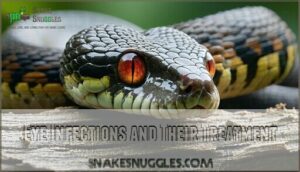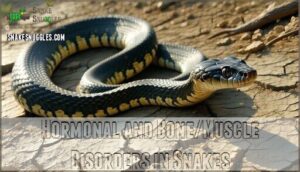This site is supported by our readers. We may earn a commission, at no cost to you, if you purchase through links.
 If you’ve noticed odd changes in your snake’s appetite, movement, or skin, and you’re thinking, “my snake has systemic diseases,” you’re on the right track to finding answers.
If you’ve noticed odd changes in your snake’s appetite, movement, or skin, and you’re thinking, “my snake has systemic diseases,” you’re on the right track to finding answers.
Systemic diseases in snakes sneak in like a thief in the night—showing up as lethargy, trouble shedding, or unexplained bumps.
These illnesses can come from bacteria, viruses, or even a tank that’s too damp or dirty.
Don’t shrug it off—early action can make all the difference.
Vet visits, clean habitats, and keen observation keep your scaly buddy slithering strong.
There’s much more to keeping your snake healthy than meets the eye, and taking the right steps can help prevent systemic diseases from taking hold.
Table Of Contents
- Key Takeaways
- Recognizing Systemic Diseases in Snakes
- Causes of Systemic Diseases in Snakes
- Digestive Disorders in Snakes
- Skin Infections and Abscesses in Snakes
- Respiratory and Eye/Ear Disorders in Snakes
- Hormonal and Bone/Muscle Disorders in Snakes
- Nervous System Disorders in Snakes
- Reproductive Disorders in Snakes
- Cancer and Tumors in Snakes
- Treatment and Prevention of Systemic Diseases in Snakes
- Frequently Asked Questions (FAQs)
- How do you know if your snake has a neurological disorder?
- What are the symptoms of internal parasites in snakes?
- What to do if my snake has IBD?
- How to tell if your snake is unwell?
- How do I know if my snake has sepsis?
- What are the symptoms of snake Cryptosporidium?
- How contagious is IBD in snakes?
- How often should I take my snake to a veterinarian?
- What is the average lifespan of pet snakes with diseases?
- Can systemic diseases in snakes be transmitted to humans?
- Conclusion
Key Takeaways
- Watch for early warning signs like appetite loss, lethargy, and shedding problems, since snakes hide illness well.
- Keep your snake’s habitat clean, with controlled humidity and temperature, to help stop most systemic diseases before they start.
- Act quickly and get your snake to a reptile vet if you spot sudden changes in behavior or physical appearance—early intervention works best.
- Stick to preventive care with regular checkups and quarantine protocols when introducing new snakes, so you catch issues before they become serious.
Recognizing Systemic Diseases in Snakes
You’ll need a sharp eye to spot early signs of illness in your snake, since they’re experts at hiding problems.
Paying attention to changes in behavior or appearance can help you catch systemic diseases before your pet becomes seriously sick—because nobody wants a sneaky snake pulling off a surprise sick day, which can be a serious issue.
Spotting small changes early keeps your snake from pulling a sick-day surprise that could turn seriously dangerous.
Common Signs and Symptoms of Systemic Diseases
If you spot Lethargy Signs, Appetite Loss, or Skin Changes in your snake, don’t ignore them—these are classic snake illness symptoms.
Neurological Issues like tremors or odd posture and Shedding Problems often point to a systemic infection.
Each clue helps with disease diagnosis, and Catching snake health problems early means better treatment and fewer snake disease symptoms down the road.
Behavioral Changes in Sick Snakes
Out of the blue, your snake starts acting different—it’s not just having a bad day.
Behavioral changes can flag snake health problems long before physical symptoms show up. Keep your eyes peeled for these tell-tale signs:
- Feeding Issues: Loss of appetite can hint at deeper snake sickness treatment needs.
- Lethargy Causes: If your usually active snake is barely moving, don’t ignore it—lethargy often signals trouble.
- Aggression Signs: A friendly snake turning snappy may be in pain or under stress.
- Hiding Behavior: Extra hiding points to stress factors or illness brewing beneath the scales.
Catching these shifts early can make all the difference.
Physical Changes in Sick Snakes
If your snake suddenly looks off, pay attention.
A sudden change in your snake’s appearance is your cue to start asking questions—don’t brush it off!
Physical issues like skin lesions, discoloration, swelling, or random weight loss aren’t just bad hair days—they might be red flags.
Shedding issues and sluggish movement can also point to deeper trouble.
Don’t brush off these changes.
Monitoring skin changes, shedding issues, and unexplained lethargy can help you catch problems early, and this is crucial for identifying deeper trouble and unexplained lethargy.
Importance of Early Detection
How can you stay one slither ahead?
Symptom recognition and diligent health monitoring are your snake’s safety net regarding systemic diseases.
Early detection isn’t just a buzzword—it’s your green light for early intervention and better outcomes.
Use diagnostic tools and regular checkups for snake disease diagnosis.
Prevent serious snake health issues with informed, proactive reptile health tips.
Causes of Systemic Diseases in Snakes
When your snake gets sick, it’s usually because bacteria, viruses, parasites, or poor living conditions have taken hold.
Don’t worry—knowing these common culprits helps you take quick action and keeps your scaly friend from planning a great escape just to get away from dirty bedding, which can be a result of poor living conditions.
Bacterial Infections and Their Impact
Noticing your snake seems off? You might be dealing with bacterial infections. These can move fast, causing systemic diseases like septicemia.
Watch for symptoms like mouth rot or crusty skin.
Want a solid plan for Infection Control? Stick to these five steps:
- Clean habitats regularly
- Quarantine newcomers
- Monitor Bacterial Symptoms
- Use Antibiotics wisely
- Schedule routine checkups
Understanding reptile septicemia is key to saving your pet.
Viral Infections and Their Impact
Catching early signs of viral infections in snakes can feel like detective work.
Watch for erratic behavior or subtle Viral Symptoms.
Stay sharp about these points:
- Disease Transmission through viral shedding
- Risks of inclusion body disease or adenoviruses
- Importance of Infection Control strategies
- Snake Vaccines availability is limited
- Use of Viral Diagnostics for detection
Act fast—supportive care often makes the difference. Understanding viral infection signs is essential for effective treatment.
Parasitic Infections and Their Impact
Parasitic infections are a sneaky foe for your pet.
Helminth Infections, Protozoa Diseases, and Coccidia Parasites can turn your snake’s appetite upside down, causing diarrhea, weight loss, and even labored breathing.
Internal parasites such as intestinal worms, skin parasites, and mite infestations often require veterinary care.
Don’t forget tick control—these little hitchhikers love reptiles, too!
Environmental Factors Contributing to Systemic Diseases
Moving from parasites to the snake’s world itself, keeping an eye on these three environmental factors could save you headaches—and your snake’s health.
- Temperature control: Keep your snake’s immune system humming with consistent heat.
- Humidity levels: Too wet or dry? You’ll see shedding and breathing issues.
- Enclosure size: Cramped quarters stress your snake—more room, less trouble!
Digestive Disorders in Snakes
You might notice your snake turns up its nose at food or leaves behind runny droppings, and that’s a clear signal something’s off in its digestive system.
Don’t panic—you’re not the first snake owner to clean up a mess and wonder if your scaly friend ate something it shouldn’t have, which can be a clear signal.
Adenoviruses and Their Effects on Snakes
Adenoviruses are sneaky culprits in snake diseases, causing liver and digestive failure that can hit hard, especially in youngsters.
Watch for sudden Adenovirus Symptoms—lethargy, weight loss, or regurgitation. With no Snake Vaccines or quick cures, prevention’s your best bet.
Boost Immune Response, keep enclosures spotless, and schedule regular vet visits.
Remember, viral shedding means hidden risks with new arrivals. Regular monitoring and strict hygiene practices are essential to prevent the spread of adenovirus infection in reptiles.
Infectious Stomatitis and Its Symptoms
With infectious stomatitis, also called snake mouth rot, you might notice mouth sores, red gums, or even pus.
Think of it like snake gingivitis—snakes can get dental issues, too!
Loss of appetite or sudden head rubbing points to oral infections.
Don’t wait—good hygiene, prompt antibiotics, and a vet’s check can keep snake disease symptoms from spiraling into stubborn systemic diseases.
Internal Parasites and Their Impact on Snakes
After tackling mouth issues, let’s talk about the sneaky troublemakers inside—internal parasites.
Helminth infections, protozoal diseases, and coccidia effects can trigger weight loss, diarrhea, and odd sluggishness.
Watch for these signs:
- Stringy stools or sudden messes
- Loss of appetite and shrinking scales
- Odd breathing or tiredness
Parasite detection and deworming are key treatment options.
Cryptosporidiosis and Its Effects on Snakes
Just when you think you’ve tackled internal parasites, Cryptosporidiosis sneaks in.
This tough cookie, part of the parasitic infections club, completes its Crypto Life Cycle right in your snake’s gut.
Diagnosis Challenges abound—symptoms hide.
Focus on strong Immune Response, smart Treatment Options, and strict Prevention Strategies.
Here’s what you need to know:
| Keyword | Effect | Solution |
|---|---|---|
| Crypto Life Cycle | Digestive upset | Clean habitat |
| Diagnosis Challenges | Hidden symptoms | Lab tests |
| Immune Response | Weakens snake | Vet support |
| Treatment Options | Limited | Supportive care |
| Prevention Strategies | Key | Hygiene, quarantine |
Skin Infections and Abscesses in Snakes
You might notice your snake developing patchy skin, bumps, or swollen spots that look a bit like it picked a fight with a cactus.
These skin infections and abscesses can turn serious fast, so you’ll want to catch them early—snakes aren’t known for sending you a memo when they’re feeling under the weather.
Dermatitis and Its Causes
After looking at digestive disorders, it’s time to shed some light on skin issues.
Dermatitis in snakes is no picnic—poor hygiene, high humidity, traumatic injuries, bacterial infections, and parasitic infestations all play a role.
These common reptile health issues can quickly turn into frustrating snake diseases.
Keep your enclosure clean and humidity just right to prevent skin infection and other skin disorders.
Ulcerative or Necrotic Dermatitis and Its Symptoms
After dealing with the basics of dermatitis, let’s get down to the nitty-gritty: ulcerative or necrotic dermatitis. This skin infection—often called scale rot—shows up fast, and can spell trouble for your snake’s health if ignored.
Blame high humidity and a messy enclosure for most cases. Watch for:
- Soft, discolored or foul-smelling skin patches
- Ulcers or open sores on the belly scales
- Sluggishness and lack of appetite
- Swelling around lesions
Prompt treatment and better hygiene help stop the spread. Left unchecked, bacterial infections may trigger septicemia, leading to severe skin disorders and a tough prognosis.
Abscesses and Their Treatment
Abscesses are like unwanted visitors for any snake, popping up due to bacterial infections, traumatic injuries, poor sanitation, or pesky parasites.
Spot swollen lumps, skin lesions, or pus pockets early to prevent bigger trouble.
Treatment means Incision & Drainage, sometimes surgical removal, followed by smart Antibiotic Choices and careful Wound Management.
A key preventative measure involves maintaining proper husbandry to minimize risks.
Don’t ignore skin infection or sudden weight loss—your snake’s health can turn fast. Act quickly, keep habitats clean, and remember: snake skin conditions like abscesses need sharp eyes and a hands-on approach.
Prevention of Skin Infections and Abscesses
Not every snake gets skin infections, but prevention is no accident—it’s good habitat management in action.
- Deep clean enclosures often for exceptional Cage Hygiene.
- Use Humidity Control to prevent snake skin conditions like ulcerative dermatitis.
- Practice regular Stress Reduction and keep things calm.
- Set Quarantine Protocols to curb environmental stressors and nip skin infection or abscesses in the bud.
Respiratory and Eye/Ear Disorders in Snakes
You’ll spot trouble breathing, nose bubbles, or a snake with one eye shut, but don’t panic—quick action helps.
Just remember, even the most stylish python can’t pull off sunglasses if they’re hiding an eye infection.
Respiratory Infections and Their Symptoms
Snake respiratory infections can sneak up fast—keep an eye out for nasal discharge, excess mouth mucus, or open-mouth breathing.
Wheezing and lethargy often mean big trouble, possibly pneumonia.
Good humidity control and proper ventilation are a must to protect your snake’s respiratory system.
Early symptoms might look minor, but without prompt care, respiratory disease can quickly become life-threatening.
Proper care is essential to prevent respiratory disease from becoming severe.
Eye Infections and Their Treatment
Spotting eye infections in snakes is key—watch for conjunctivitis symptoms like redness, swelling, or goopy discharge.
Retained eyecaps and corneal infections are common headaches for keepers.
Treatment options include antibiotic ointments or, rarely, surgical options.
Good hygiene helps prevent issues, but when in doubt, don’t wing it—seek veterinary care to safeguard your snake’s sight and well-being.
Ear Infections and Their Treatment
Ear infections in snakes often stem from aural abscesses deep in their ear anatomy.
You’ll need prompt veterinary advice—don’t drag your heels! Most cases call for surgery as part of snake medical treatment, where infected tissue is flushed and removed.
Post-op care is essential to prevent hearing loss. Trust reptile medicine pros for proper ear infections and surgical options.
Prevention of Respiratory and Eye/Ear Disorders
Properly avoiding snake respiratory system and eye/ear issues means consistently nailing the basics.
Keep an eye on these points:
- Control humidity for healthy shedding.
- Maximize ventilation—a stuffy tank spells trouble.
- Stick with strict hygiene practices when cleaning the snake enclosure.
- Quarantine protocols help prevent new infections.
- Try regular monitoring and watch for sneaky environmental stressors.
Your snake’s future self says thanks for following these protocols!
Hormonal and Bone/Muscle Disorders in Snakes
Hormonal and bone or muscle problems in snakes can sneak up on you, leading to weak movements, odd postures, or even strange jaw growths.
If your snake suddenly looks stiffer than your old garden hose, it’s time to pay close attention to odd postures.
Hormonal Imbalances and Their Effects
Just like with breathing troubles, hormonal imbalances can sneak up and rattle your snake’s routine.
Endocrine disruptors may trigger everything from thyroid issues to odd growth or skin changes.
Watch for signs like stubborn shedding or unexpected appetite shifts.
Left unchecked, these issues affect calcium regulation and can even create reproductive disorders.
If something’s off, a vet is your best friend.
Secondary Nutritional Hyperparathyroidism and Its Symptoms
Many snakes with secondary nutritional hyperparathyroidism show worrying changes from a calcium deficiency. You might see bone weakness or muscle tremors. Jaws can soften and fractures happen easily.
Poor diet and low UVB are big culprits. Don’t wait until organ damage sets in—diet correction and vet care are essential for your reptile’s health.
- Rubbery jawlines in ball pythons
- Lethargic boas stretched out
- Awkward, shaky corn snake movements
- X-rays showing faded snake skeletons
- Owners scrambling for better supplements to address the issue of calcium deficiency.
Abnormal Beak Growth and Its Causes
In the context of abnormal beak growth in snakes—a rare but real problem—you’ll likely see Beak Overgrowth thanks to Nutritional Deficiency, Trauma Impact, Genetic Predisposition, or Infection Causes.
These issues make eating tough and can signal deeper snake diseases like secondary nutritional hyperparathyroidism.
Early snake veterinary care is key for pet snake care.
| Cause | Example Symptom | Prevention Tip |
|---|---|---|
| Beak Overgrowth | Misshapen mouth | Balanced diet |
| Nutritional Deficiency | Weak jaw | Calcium supplements |
| Trauma Impact | Crooked beak | Gentle handling |
| Genetic Predisposition | Unusual growth | Monitor lineages |
| Infection Causes | Swollen tissues | Proper hygiene |
Treatment of Hormonal and Bone/Muscle Disorders
Bone and muscle problems in snakes, like secondary nutritional hyperparathyroidism or spinal osteopathy, need a hands-on approach.
Here’s what can help:
- Hormone therapy for hormonal imbalances
- Calcium supplementation and dietary changes
- UVB lighting and environmental changes
- Physical therapy or surgical options if needed
Even the sneakiest snake can’t fix this without you, and a hands-on approach is necessary to address these issues, including hormone therapy.
Nervous System Disorders in Snakes
When your snake starts showing odd movements or has trouble balancing, you might worry it’s trying out for a circus act.
Nervous system disorders in snakes can be tricky, but knowing the signs helps you spot problems early and get your pet the right care.
Neurological Disorders and Their Symptoms
When you spot your snake acting off—think head tilting, incoordination, or even outright paralysis—it’s more than just a mood swing.
Neurological disorders bring tremors and seizures, making your pet struggle like it’s walking on marbles. Lethargy may set in, and Salmonella enterica sometimes plays the villain.
These behavioral and physical changes call for careful observation, including signs such as:
- Head tilted at odd angles
- Full-body shakes or seizures
- Snake dragging itself (paralysis)
- Sudden muscle spasms or seizures
Spinal Osteopathy/Osteomyelitis and Its Effects
A snake dragging its tail or struggling to move might be facing spinal osteopathy or osteomyelitis—painful spinal infections that lead to vertebral damage and mobility impairment.
These systemic diseases can show up as lethargy, clumsy movement, and a loss of appetite.
Don’t wait—veterinary attention is your best move, as early intervention and pain management offer the best treatment options for these neurological disorders.
Mycobacteriosis and Its Impact on Snakes
In the context of systemic diseases in snakes, mycobacteriosis shouldn’t be taken lightly.
This bacterial infection can sneak up quietly, causing:
- weight loss, odd behavior, or even paralysis,
- hidden granuloma formation as your snake’s immune system tries to wall off the infection,
- mycobacteria transmission from contaminated environments or wounds,
- diagnosis challenges since detecting snake bacterial infections isn’t easy.
These infections can sometimes be identified through fecal parasite exams.
These snake diseases also have zoonotic potential, so always use gloves and practice exceptional hygiene.
Early detection and proper care are your best bet for recovery.
Treatment of Nervous System Disorders
After mycobacteriosis, treating nervous system issues like seizures and tremors calls for a careful approach.
Your vet will run a neurological exam and may suggest Seizure Management, Tremor Reduction, or Spinal Support if spinal osteopathy is at play.
Improving phosphorus levels helps with Nerve Regeneration and Pain Alleviation.
Good husbandry reduces relapse, letting your snake reclaim calmer, steadier days.
Reproductive Disorders in Snakes
If your snake refuses to lay eggs or shows swelling, you could be facing a reproductive disorder that’s tough to spot early.
You’ll need sharp eyes and quick action—these problems don’t solve themselves, and your snake certainly won’t send you a memo.
Common Reproductive Issues in Snakes
After exploring nervous system disorders, let’s talk about reproductive disorders—common headaches for both keepers and snakes.
Dystocia causes plenty of stress, with egg binding often leading to toxemia if not spotted early.
Infertility factors can be tricky too, especially in poorly managed breeding.
Watch for these:
- Egg binding or retained eggs
- Infertility due to environmental issues
- Reproductive cancers affecting older snakes
Causes of Reproductive Disorders
A handful of culprits can trigger reproductive disorders in snakes.
Infections, poor husbandry, and nutritional deficiencies are common troublemakers, often inviting hormonal imbalances or even dystocia during snake breeding or egglaying.
Genetic factors can stack the odds, while environmental toxins sneak in silently too.
Clean habitats, balanced diets, and careful breeding go a long way in keeping your snake’s reproductive system running smoothly, which helps prevent reproductive disorders and ensures a healthy environment, thus supporting overall reproductive system health.
Symptoms of Reproductive Disorders
With reproductive disorders in snakes, the signs can sneak up on you faster than a python on a mouse.
Watch for Dystocia symptoms like persistent restlessness or a visibly swollen abdomen—these point to egg binding or follicular stasis.
Hormonal imbalances often lead to unusual shedding or abnormal, misshapen eggs.
Keep an eye out for changes that just don’t feel right, especially:
- Restlessness or excessive hiding
- Swollen or distended cloaca
- Discharge or visible prolapses (Prolapses signs)
- Weight loss or refusal to eat
- Abnormal eggs or unexplained discomfort
Treatment of Reproductive Disorders
You’ll often find that treating reproductive disorders in snakes—like egg binding or dystocia—means getting hands-on.
Warm water soaks might loosen things up, but sometimes, your vet will need to assist with manual extraction or even surgery, particularly for severe oviductal issues or prolapse repair.
Hormone therapy is another tool, especially when hormonal imbalances throw snake reproduction off course.
Tackling phosphorus imbalances means adjusting their diet.
Stay alert and partner closely with your vet—Dystocia Management often saves the day for these tough cases, and it’s crucial for successful reproduction and hormone therapy.
Cancer and Tumors in Snakes
You might notice your snake has lumps or swelling that don’t disappear, and it’s not just from eating a big meal.
Cancer and tumors aren’t common in snakes, but catching them early gives your pet a much better chance at recovery.
Types of Cancer in Snakes
Snake cancer comes in several types: squamous cell carcinoma, adenocarcinoma, lymphoma, osteosarcoma, and fibrosarcoma.
Where the tumor shows up—like liver, kidney, or even bone—affects how you spot it and what treatment your vet may suggest.
Early diagnosis matters, so knowing these cancer types gives you an edge in understanding snake disease and making decisions about treatment.
Symptoms of Cancer in Snakes
Spotting cancer in snakes takes a sharp eye and attention to detail.
Watch for:
- Unusual lumps that grow (Tumor Location and Growth Rate)
- Unexplained weight loss or sudden behavioral changes
- Persistent skin lesions that refuse to heal
Diagnostic Imaging or Biopsy Analysis is needed to confirm cancer.
Metastasis Signs can include swelling or breathing issues. Don’t ignore odd symptoms!
Attention to these signs is crucial for early detection and treatment.
Treatment of Cancer in Snakes
Wondering how to treat cancer in your snake?
Treatment options include Snake Cancer Surgery to remove tumors, Chemotherapy Snakes, and even Radiation Therapy.
Sometimes, Immunotherapy Snakes or Palliative Care helps manage symptoms.
Early detection makes a difference, and your vet will guide you through snake disease treatment options.
Here’s a comparison for clarity:
| Option | Purpose | Typical Use |
|---|---|---|
| Surgery | Remove tumors | Localized cancer |
| Chemotherapy | Kill cancer cells | Blood or organ cancer |
| Radiation Therapy | Target cancer area | Some tumor types |
Prevention of Cancer in Snakes
While treatments exist, preventing cancer in your snake is always easier.
Here are a few practical snake care tips:
- Watch for genetic predisposition by learning your snake’s background.
- Prioritize diet’s role—keep meals varied, with the right calcium and phosphorus.
- Focus on toxin avoidance by using safe materials and minimizing environmental stressors.
- Stick to solid husbandry practices and schedule early detection checkups with a reptile vet.
Treatment and Prevention of Systemic Diseases in Snakes
You can help your snake fight off systemic diseases with the right treatments and a few changes to their routine.
Don’t worry if you’re not a reptile expert—small shifts in care and quick action can make a big difference for your scaly companion.
Antibiotics and Their Use in Treating Systemic Diseases
When bacterial infections or sepsis strike your snake, antibiotics often become your best ally.
Always rely on sensitivity testing before starting medication—guesswork isn’t your friend here.
Careful dosage calculation and choosing the right administration route matter for safer, faster results.
To help prevent Antibiotic Resistance, finish the full course and consider adding probiotics to counter gut upset during systemic diseases and septicemia treatment.
Many owners buy snake antibiotics from online retailers.
Antiviral and Antiparasitic Medications
When dealing with systemic diseases in snakes, choosing the right antiviral and antiparasitic medications matters. Don’t fly solo—always consult a reptile vet for personalized advice and to dodge unexpected medication side-effects.
Here’s your survival kit:
- Monitor for parasite resistance
- Ask about novel treatments and antiviral efficacy
- Never skip preventative medication protocols
- Track your snake’s behavior during treatment
Get ahead of issues, not behind them! Effective treatment may require snake antiviral medication.
Dietary Changes and Their Impact on Systemic Diseases
After covering meds, let’s shine a light on snake nutrition. Avoiding snake disease nutritional deficiencies means paying attention to food quality, diet adjustments, and proper supplementation strategies.
Hydration importance can’t be overstated either—always keep fresh water available. If your snake shows anorexia or digestive issues, check their diet.
Providing the correct aquarium substrate options also contributes to a healthy environment. A well-fed snake’s gastrointestinal system stays strong, helping prevent systemic diseases long-term.
Environmental Changes and Their Impact on Systemic Diseases
When you optimize conditions in your snake’s enclosure, you fight systemic diseases head-on.
A quick checklist for a healthy space:
- Check Humidity Levels and use a reliable gauge for snake humidity control.
To maintain proper humidity, consider using a digital reptile hygrometer.
- Fine-tune Temperature Control to encourage natural behaviors.
- Keep Enclosure Size roomy enough for stretching out.
- Practice rigorous Cage Hygiene and enforce Quarantine Protocols—snakes love a tidy, safe home environment.
Frequently Asked Questions (FAQs)
How do you know if your snake has a neurological disorder?
Think of a snake acting oddly, like it’s dancing to its own tune—watch for tremors, uncontrolled twisting, or seizures.
If your snake shakes, strikes at nothing, or can’t right itself, a neurological disorder might be to blame.
What are the symptoms of internal parasites in snakes?
You’ll spot symptoms like weight loss, diarrhea, poor appetite, and trouble shedding.
Sometimes your snake seems cranky or hides more often.
If you see worms in poo, that’s a smoking gun.
Vet checkups catch trouble early.
What to do if my snake has IBD?
If your snake has IBD, get them to an experienced reptile vet right away.
They’ll need symptom management, isolation from other snakes, and spotless hygiene.
There’s no cure, but quick action helps keep things from going further south, which is why quick action is crucial.
How to tell if your snake is unwell?
Lethargy, skipping meals, or hiding out too much wave red flags.
If your buddy acts cranky, breathes oddly, sheds poorly, or looks thinner, it’s time to call the vet—better safe than sorry!
How do I know if my snake has sepsis?
Picture your ball python suddenly lying limp, refusing food, and showing red patches on its belly.
If you notice labored breathing, swollen body parts, or pus from wounds, sepsis could be at play.
Call your vet immediately!
What are the symptoms of snake Cryptosporidium?
Your slithery pal might show weight loss, runny stools, trouble swallowing, and swelling near the mouth.
Watch for regurgitation, poor appetite, and a thin, “pinched” look.
Cryptosporidium throws snakes off their groove—call your vet fast to address the issue of regurgitation.
How contagious is IBD in snakes?
Ever worried if one sick python can topple the whole collection?
IBD (Inclusion Body Disease) spreads easily between snakes, especially boas and pythons.
Don’t share tools or enclosures—strict hygiene and fast quarantine protect your pets, as IBD can be particularly harmful.
How often should I take my snake to a veterinarian?
Plan on seeing a reptile vet once a year for a routine checkup.
But bump visits up if you spot any changes in appetite, shedding, or behavior.
When in doubt, it’s better to check than guess.
What is the average lifespan of pet snakes with diseases?
When illness strikes, even the toughest scales can’t weather the storm forever.
Most pet snakes with chronic diseases live two to five years, but careful care and regular vet visits can help stretch those precious years longer.
Can systemic diseases in snakes be transmitted to humans?
Most systemic diseases in snakes don’t jump to humans, but a few rare ones might, especially if you skip on hygiene.
Always wash your hands after handling your snake or cleaning its enclosure.
Better safe than sorry!
Conclusion
Sometimes, it’s no coincidence you’re searching “my snake has systemic diseases” right after noticing something’s off in your pet’s routine.
Detecting symptoms early and acting quickly makes all the difference.
Keep a close eye on appetite, movement, and skin condition.
Don’t ignore changes—these signals can help your snake survive systemic diseases.
With swift vet care, a clean habitat, and regular checks, you’ll give your snake the best shot at a long, healthy, slithery life.
- https://www.vetfolio.com/learn/article/systemic-diseases-of-reptiles
- https://vcahospitals.com/know-your-pet/snakes-diseases
- https://www.petmd.com/reptile/care/evr_rp_how-can-i-tell-if-my-snake-sick
- https://www.petcoach.co/article/egg-binding-dystocia-in-reptiles-causes-signs-diagnosis-tre/
- https://pmc.ncbi.nlm.nih.gov/articles/PMC10891919/





















